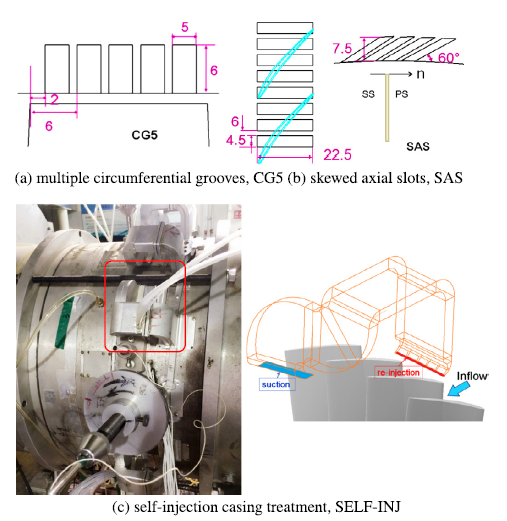A novel integral method is proposed to quickly assess the effectiveness on stability improvement with end-wall casing treatments. With this low-cost method, efficacies for various casing treatment configurations can be evaluated instead of calculating the entire performance curves, which can be used in place of expensive and costly experiments. The underlying mechanism for this approach is based on the hypothesis that the spike stall precursors can be triggered by the forward spillage of the rotor tip leakage flow, and the onset condition of such a spillage is determined by the axial momentum balance within the rotor tip region. Based on the simulation, a series of control volumes are set at the rotor tip region in order to catch the axial momentum balance between the incoming main flow and the reversed tip leakage flow. Cumulative axial momentum distributions for these control volumes named as “bell-shaped curves” are presented to evaluate the effectiveness of different configurations. The axial location of the bell curve peak indicates the time-and spatial-averaged interface position between the main flow and tip leakage flow, which moves upstream during throttling. Three types of typical casing treatments: multiple circumferential grooves, skewed axial slots and self-injection configurations for a low-speed in-house compressor are evaluated by their bell-shaped curves. Among these configurations, the skewed axial slots has the most downstream of the peak, followed by the multiple-grooves, while the self-injection configuration shows the least. Based on an existed experimental result for a double-groove configuration, the effectiveness of the three studied casing treatments are predicted by their locations of the bell-shape curve’s peak without simulating the entire performance curves. The assessments are then validated by experiments.
Conclusion
Based on the understanding on the stall mechanism of tip-critical axial compressors, a novel post-computational method is proposed and applied to assess the effectiveness of the three typi-cal end-wall treatments in this paper. Conclusions can be summa-rized as follows:
1. An integral method is developed to assess the efficacy of the casing treatment without calculating the entire performance curves. The basic idea of this method is to compare the time-and spatial-averaged locations of the MF/TLF interfaces among various casing treatment configurations at the near stall point of the smooth casing. This interface is viewed as an integral effect of the axial momentum balance between the main in-coming flow and the tip reversed flow.
2. Cumulative axial momentum distribution of the tip region named as bell-shaped curves is proposed to correlate the mechanism of flow field with the compressor stability. The ax-ial location of the peak (Zbp) is considered as the spatial-and time-averaged axial location of the complex 3D MF/TLF inter-face. The Zbp decreases during the throttling, which indicates the interface moves towards rotor leading edge when the com-pressor approaches to stall.
3. The accuracy of the bell-shaped curves is discussed. It is found the height, width of integral regions are insensitive with Zbp. Multi-and single-passage simulations are also discussed to en-sure the single passage simulation can suggest a rational Zbp value with engineering accuracy.
4. Three different types of typical casing treatments are assessed by the bell-shaped curves. Their SMI values are further pre-dicted through a comparison of Zbp value with a known SMI configuration.
5. Experiments are conducted to verify the assessments. The measured SMI trends are consistent with the assessment, which confirms this method not only can compare the effec-tiveness for various casing treatments, but also can provide a preliminary assessment on SMI.
By simply simulating the operating points at near stall mass flow rate for smooth casing, and comparing the bell shape curves, the efficacy of the candidates of grooved casings can be easily assessed in a short time. This method is quite different from the common approaches that calculate the stall margin by numerically capturing the whole performance curve. It is well recognized that many difficult challenges still exist in capturing the experimental stall point with current numerical technologies. Highly refined meshes, sophisticated turbulence model, full-annulus computation domain, etc. would be needed in order to accurately capture the unsteady stalling processes. The proposed approach avoids these difficulties by concentrating the numerical efforts on the near stall points in which the flow physics would be much simpler than the stall inceptions. This simplification, plus the post-CFD data analysis with control volume approach, significantly reduces the requirements on the numerical schemes, and thus make it pos-sible to quickly screening a variety of casing treatments before involving high-fidelity, full-annulus and time-accurate simulations with highly sophisticated turbulence models. The reliability of the proposed approach lies on the hypothesis that the spike stall pre-cursors could result from the leading edge spillage of the MF/TLF interface, which has been and continue being tested in the com-pressor research community. Although this paper is concentrated on isolated rotors, the authors are confident that it should work in multi-row or multi-stage environment which exhibit the similar tip-sensitive stalling behavior.
The authors plan to continue refine the method. In a short term, more sophisticated numerical schemes will be explored to capture the entropy production in order to perform efficiency analysis for casing treatments. In a long term, several sub-modules, such as the selection of the casing treatment geometry, the auto grid genera-tion, as well as the efficiency assessment will be integrated to form an automatic optimization analysis platform.
The results have been published on Aerospace Science and Technology 52 (2016) 234–242.

The studied end-wall treatments.